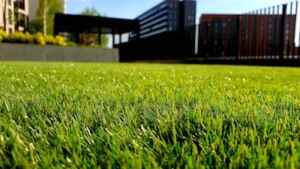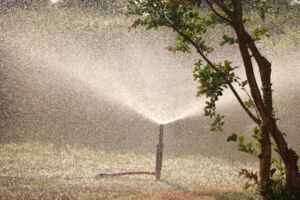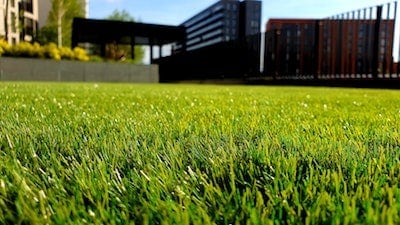Reasons Your Lawn Is Thin And How to Fix It
If you’ve ever had a yard that was full of bare patches and areas where the grass is too thin, then we want to help. My goal is to ensure your lawn has all three: thick turf with plenty of green color throughout. I understand why some people are hesitant or unsure about how they can achieve this; it certainly isn’t an easy task when faced without knowledge on what steps need taken. Luckily for those who have time (and determination) there are ways in which one can do so! Read below in order to learn more about the reasons behind these problems, as well as their solutions- both short term and long term ones available!
If you have a goal of achieving a full yard that is thick, lush, and green, and you aren’t sure how to get started, I’m going to cover why your lawn is thin and how to fix it.
Why is my Grass Thin? Grass starts to thin when it is infested by pests, isn’t getting enough sunlight exposure, or the soil has been compacted too firmly. The problem of thin grass can generally be fixed with a thorough fertilizing and seeding process that ensures the lawn gets plenty of light from both natural sources as well as artificial ones.
It is important to note that the individual state of each lawn will have a big impact on what methods you end up choosing for regular lawn maintenance.
But what are some of the other ways you can invest in the health of your lawn? Read on to find out about methods that can help you maintain a yard that you can be proud of all year long.
Ways To Maintain A Healthy And Lush Lawn 
Most of us settle into thinking that if we mow our lawn once a month, the rest should take care of itself. This is most certainly not the case. A beautiful lawn takes time, dedication, and knowledge of how to use certain tools and techniques to turn the worst patch of dirt into a beautiful masterpiece.
Some of the other ways you can maintain a healthy lawn and encourage your grass to grow thick are to:
Adjust The Height Of Your Lawn Mower Blades
Most of us set our lawn mower blades to one height and leave them there, or if we do adjust them it is at random. Believe it or not, adjusting the height of your blades when you cut grass throughout the year can have a big impact on what kind of growth happens in your yard.
For example, using a blade height of 1 – ½ inches during the very first mowing of the year gets rid of any of the grass that has died which allows much more sunlight to get through to encourage growth.
You also want to make sure that you are using a blade that has been balanced and sharpened, and that you keep it maintained throughout the year. The reason for this is a damaged or dull blade doesn’t cut the grass, it just shreds it up. When this happens, the grass will start turning yellow and needs much more nutrients and water to get back to a good place.
It is recommended that you maintain your lawnmower blade 1 – 3 times a year to get the most positive results.
Water Your Lawn Strategically to Prevent A Thin Lawn
While it may be a no-brainer, watering your lawn correctly can be one of the most important things you can do to generate healthy and sustainable growth.
Waiting for it to rain every once in a while or only watering it lightly simply won’t be enough to get the job done. When you only water your lawn lightly, it only gives moisture to the top of the soil which causes shallow root growth. This makes your grass need even more waterings in the long run.
Instead, make sure your yard is getting at least 1 – 2 inches of water a week. This could come from sprinkler intervals around 4 times a day, or it could come naturally from the rain. Regardless, making sure your grass is not underwatered is one of the best ways to keep your grass looking thick and full.
Use Weed Killers And Fertilizers to Grow a Thick Lawn
Weed killers and fertilizers are a great way to help your grass flourish if you know how to use them. Weed type, condition of the soil, grass type and geographic location are all factors that need to be considered when applying one of these methods.
The best time of year to combat weeds is in the early summer or spring well before any of them can reproduce, create root systems, or go to seed. When fertilizing, it is best to start early on in the spring so that the root development can be kickstarted.
Make sure you take some time to read through manuals and packaging before attempting to administer anything. Some chemicals react specifically when moisture is around, while others don’t work at all if there is water present. These along with safety warnings are an important step of the process.
Utilize The Technique Of Lawn Aeration to Avoid A Thin Lawn
Your lawn needs more than just nutrients and water, it needs oxygen too. The technique of aeration is one of the best ways to solve this problem, and is easy to do for any homeowner.
The process involves using a device to pull out plugs of soil so that soil-to-air interaction is improved. Aeration also allows fertilizer and moisture to go deeper into the ground.
Soil compaction is reduced as the ground is aerated, so there is room for new roots to flourish. Once these roots have had room to grow, it means a more lush and thick lawn as a result.
The best time of the year to take advantage of aeration is in the fall.
Mistake To Avoid If You Don’t Want A Thin Lawn
So now you have taken some time to learn about some of the best ways to take care of your lawn, and your grass will be better off for it.
On the flip side, there are 3 things you should avoid when doing lawn maintenance that might make your lawn thinner. They are:
1. Overwatering Your Lawn 
Like we mentioned above, watering your lawn is a very good thing and necessary if you want to have thick and luscious grass. On the flip side of that, overwatering your lawn can cause your grass to suffocate because it isn’t able to get the amount of oxygen that it needs.
Instead of running a sprinkler every single day of the week, remember to be strategic in how much water your grass is getting.
2. Setting Your Mower Blades Too Low
It seems like common sense that the shorter you cut your grass, the less you will need to cut it right? Surprisingly, this is wrong.
One of the biggest mistakes you can make when cutting your lawn is having your blades set too low. When grass is cut too low, it eliminates the reserved energy that it has been storing up. This can kill the grass and leave your yard with bare patches that make it vulnerable to unwanted weeds taking over.
The best thing to do is plan on mowing your lawn to a length of 2 – 3 inches, and adjust accordingly as the year goes on.
3. Overlooking Safety Measures
Ignoring or overlooking safety measures can not only cause harm to you or your loved ones but also your property. Before doing anything else, take time to get rid of any branches, stones, sprinklers, or any other obstacles that might be blocking your way before you start mowing for the day.
For your safety, make sure to wear earplugs to protect your hearing, goggles to protect your eyes, and closed-toe shoes to protect your feet.
Conclusion
We hope you have found this information helpful as you start your journey towards a thick and beautiful lawn that the neighbors will be jealous of.
For more information on long term lawn maintenance, be sure to reach out to your local lawn service today!

